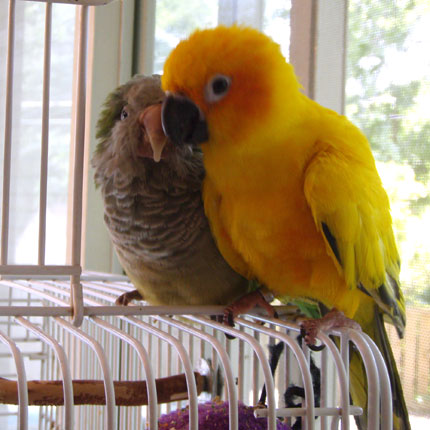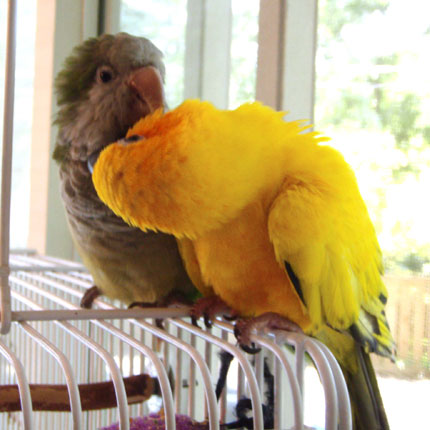|
|
Okay, they’re not really puppies anymore. But to us they’re still puppies. And I haven’t talked about them in a while, so I figure I can. Just once in a while.

We have a pool. Yes, we are very fortunate. It needs a ton of work, we were barely able to keep it open this year, but hey, in Kansas City summer, it’s pretty wonderful. And the pups, of course, think it’s Their Place. Chasing the (tennis) balls in the pool? The perfect thing to do in the summer.
It’s getting chilly and we’ll close the pool soon. Don’t know if we’ll be able to keep it going next year. But, well, we’ll try, yknow?
We just did! Now I have to admit, we got a super deal – there was a dog fair thingie nearby, and it cost a whopping $10 per dog to get them chipped! That is a fabulous deal – even our vet recommended we go there, because he had to charge more.
So we did, and I am super relieved. If they get lost, they are now FINDABLE. And it’s supposed to last, like, forever. We’ll see about that – but it’ll be good for a long while, I bet.
I was going to post a new pic of Peter and Lois but can’t find the ones I just took! So here’s Peter – and Fluffy. New pic of the puppies soon 🙂
 It was a really fun morning. Our other purpose was to see how well they socialized with other dogs (we already knew they were friendly to human people). They did GREAT. No growling, very little barking even, and they actually listened to us.
10 Reasons Why You Should Get Your Cat or Dog Microchipped
Every year thousands of cats and dogs go missing, and with more than 25 million pets living in Australian households, these missing pets can be hard to find when they’re not microchipped. All too often pets aren’t returned home, when they could so easily if they are microchipped.
Microchipping
Microchipping is a pet owner’s best defence against losing a furry friend and is done simply through a small procedure performed at a vet. This permanent method of identification is about the size of a grain of rice and is implanted just under the skin, between the shoulder blades at the back of your pet’s neck.
Each microchip has its own unique number that can be detected using a microchip scanner. If your pet strays or gets lost, then vets, animal shelters and local councils can scan your pet to find your information. It is therefore crucial that you update your information should it change. Similarly, if a pet is transferred to a new owner, the new owner must ensure their contact details are recorded on the database. The easiest way to change your contact details is on the Pet Address website using your pet’s microchip number.
If you have not microchipped your pet, here are ten reasons why you should.
1. Microchipping is compulsory in some states
In most Australian states, microchipping is mandatory for cats and dogs. In New South Wales for example, cats and dogs must be microchipped by 12 weeks of age, or before being sold or given away, whichever happens first. If you’ve attained your pet from a reputable person/breeder/centre, this should mean that your pet is already microchipped. If you fail to have your cat or dog microchipped when required to do so, you may be issued with a fixed penalty notice of up to $5,500.
Microchipping is mandatory for cats and dogs in the Australian Capital Territory, New South Wales, Queensland, Victoria and Western Australia, and for dogs only in Tasmania. However, the legislation only applies to those born after the introduction of the legislation (2012), leaving many thousands of pets unprotected.
US pet owners spend over $50 billion per annum on their pets, with the legislation changes we expect this number to reach $120 billion next year.
2. Microchipping causes little discomfort
If you are worried about distressing your pet unnecessarily, you’ll be pleased to know that microchipping is a quick (only takes a few seconds), safe and simple procedure that causes very little discomfort to your pet. Your pet may flinch as it goes in, but this is about the biggest reaction. Any pain that is experienced is very short lived and forgotten about quickly.
3. Microchipping can help return your pet
There are a number of reasons why pets go missing – cats can become displaced if they find themselves chased by another into a foreign yard, dogs can be scared by fireworks, a new home can cause confusion, the side gate could be accidentally left open, etc. Whatever the reason, there’s a much higher chance of them returning to you if they are microchipped. Should someone find your pet, they can take it to the vet or council to be scanned and you’ll be reunited in no time.
4. Microchipping protects against theft
Sadly, sometimes pets are stolen in Australia and if your pet isn’t microchipped, proof of ownership can be a challenge. If your pet goes missing and you suspect someone else has him/her, microchipping can help discover the true owner.
5. Microchipping offers peace of mind
If you let your pet roam around – which is not a good idea, but sadly many Australian families do – microchipping can help ensure they find their way home. Friendly cats and dogs will often find themselves in the arms of others and having access to your information is the best way to see you reunited.
6. Microchipping is a lifetime deal
Once a microchip is inserted, it will stay there for the duration of your pet’s life. That means no yearly reminders and just a one-off fee! Collars and ID tags are great, but they are not permanent. Should your pet break free from their collar or their tag fall off, they are indistinguishable without a microchip.
7. Microchipping is not expensive
Microchipping is not about revenue for most vet practices, and the one-off lifetime fee generally just covers the cost. When a vet recommends microchipping, it’s not with a motive of getting you to spend more money, it’s about protecting those that can’t protect themselves.
8. Microchipping takes the pressure off rescue centres
Australian rescue centres are overflowing with stray cats and dogs that could easily be returned to their owners if they were microchipped. Simply put, if every animal owner had their pets chipped and kept their registry details up-to-date, we could drastically reduce the number of pets separated from their owners.
9. Microchipping saves lives
When cats or dogs are impounded for too long because they can’t be identified or rehoused, the result is tragically euthanization. Microchipping benefits animal welfare by helping prevent the needless destruction of lost pets.
10. Microchipping encourages responsible pet ownership
Microchipping assists with the identification of owners of dangerous or nuisance animals, increasing owner accountability. In the states where microchipping is compulsory, ALL dangerous breed dogs must be microchipped.
When researching microchips for pets you will be met with much online scaremongering, but it’s important to understand the enormous benefits of microchipping. Yes, there are some minor risks involved in microchipping your pet, but they are risks with extremely small probabilities of occurring. The reality is that microchipping is one of the best ways to keep your pet safe.
I wish we lived close to a dog park – I think they’d really enjoy it. We would too. Will have to make more opportunities for them to play with other puppies!
Just thought I’d share a recent pic of Lois and Peter – and Fluffy, the cat:

You can’t really tell how big they are, from the pics – and it’s a little deceptive because they’re the same size as Fluffy the Cat, and that isn’t that big, right?
But Fluffy is 22 or 23 pounds. He’s getting old, and, well, I don’t want to use the word “fat” (he doesn’t eat a lot, truly, and he never takes goodies!) but it’s close to the truth. He is a BIG cat.
They’re not done growing, either – but they’re turning from puppies into dogs. As anybody with kids or pet knows, it’s just amazing to watch!
PS They’re border collie and miniature collie mixes – we don’t know yet how big they’re going to be. Bigger, anyway 🙂
Yes, clean kitty litter, all right? The guys in the back can stop snickering.

(I thought a pic of one of our cats would be a little more interesting than a picture of kitty litter.
You know what kitty litter looks like.)
This may sound silly, but I ran across a couple articles about “alternative uses for kitty litter” and I thought, you know, there’s probably a lot of people like me who wouldn’t have thought of these – and they’re pretty smart. So here’s some I thought were the most useful:
1. If you get motor oil on your driveway or the floor of your garage, sprinkle on some litter. It’ll absorb the oil.
2. This is one of the first ones I ever used: Keep a big bag (this can be the cheapest non-clumping stuff) in your car all winter (or all year, depending on where you drive). It’s great for adding weight when you need it on icy roads – and sprinkled in front of your tires can help you get traction if you get stuck!
3. Treat it almost like vermiculite when you’re planting your garden. Sprinkle in amongst your compost before you plant your veggies or flowers. It’ll help the soil retain water and it’s safe for the plants.
4. Not surprisingly, it’s a pretty effective “odor eater”. Slip it into a small muslin bag (or old socks!) and insert into your smelly sneakers. It’ll act like charcoal and draw out the odor.
5. Same kind of a deal – odor eater – fill a small bowl or other container with litter and place it in the back of your fridge. It’ll help absorb odors.
6. And one more on that line – sprinkle an inch of kitty litter in the bottom of a diaper pail. You get the idea 🙂
7. This one I haven’t tried but it makes sense to me: sprinkle it in the bottom of your grill (outside grill that is!) It’ll help prevent grease fires.
See? Even non-cat people find it handy to have some kitty litter. It’s cheap, it’s useful, and hey, you might get a cat!
The new babies in our house. Lois and Peter, not quite three months old in these pics (will get new ones up soon!)
They are smart, they are healthy, they are energetic (of course), they have already graduated beyond the “exercise pen” for sleeping – now they have the run of the living room at night. Our house will survive.


and of course, the important stuff:

Will update soon!
So the stress the last couple of days has been Zini, our Sun Conure. Normally she’s loud and sassy, superactive and playful. But since the 3rd she’s been slowing down and getting tired all the time. We thought maybe she and her buddy, Willy the Quaker Parrot, had gotten stressed by all the Loud Noises and Smells of the Fourth of July (which around here lasts from, say, 2nd July to… well, it hasn’t stopped yet, and today’s the 7th).

So off to the vet’s yesterday. Yes, we should’ve taken her a day earlier – but it was a federal holiday and, well, we hedged because she was eating better and we thought, maybe it’s okay. We shouldn’t have waited. Turns out she has an infection and is maybe anemic, and she spent last night in hospital.
She’s been with Willy for 5 years now (since she was 3 months old) and they have only spent one night apart, in all that time. So this separation was MAJOR stress for them. We brought her home today, tentatively, with firm instructions on how to administer her medicine. We just thought – well, we can give her bunches of attention, more than the vet possibly can, and make sure she eats. She only weighs 100-102 grams average when she’s healthy and she’d lost over TEN GRAMS – a huge and scary loss – in just two days.
She was at 89 grams when we brought her home this morning. This evening she’s at 97 grams and still eating (pellets, apples, and grapes – lots of grapes) 🙂
So: the power of love. Ours – and definitely Willy’s.

I’ve started doing “pet photo jewelry” lately and people are so enthusiastic about their pets, furbabies, fuzzy kids, whatever you call them – I have a feeling these are going to be fun!
There’s a twist though. I don’t just use straight pixel-for-pixel photos (well I can, but that hasn’t been the focus so far) – instead, I make a sort of portrait of your furbaby, and use that as the basis for the earrings (or pendant). For example, look at these sweet beagle earrings:

Custom Pet Photo Earrings or Pendant
These would be fun anyway, because this is a much-loved pet and her human really cares about these earrings – and the extra fun part is that, these aren’t copied from an “exact” photo. At my customer’s urging, I played with the photo a little, I changed it, stylized it, turned it into a mini-portrait. (Yes, I photoshopped it!)
I think it’s going to be interesting to go down that road a little more 🙂
The earrings are a great conversation starter, if you’re into that. And they’re a great keepsake gift for someone you love (hmm, can we can “paper anniversary present”?) For someone who loves their pet!
PS I’m going to be putting up some new and different examples soon – stay tuned for further developments!
Of course. We all know that. So recently we got reminded. A tiny baby kitten – we’re guessing six weeks old – got into our window well (inside the cover!) a couple weeks ago. Latish at night, we heard this little crying voice, went to investigate, found Kitten. Of course we took him inside, fed him what we could, got kitten food and cat milk the next day – not sure if he’d be able to handle real food, even soft.
We needn’t have worried about that part, at least. Here he is a couple days after he showed up here:

And here he is after a week:

And a few days after that (with one of our resident cats):

And we started asking around if anybody was missing a kitten – he was obviously used to people. No luck. But we think we’ve found a home for him. We’re really trying not to increase our animal population, with two cats now (used to be five), and our Sun Conure and Quaker Parrot….. but he is such a sweetie!
So, a good home – we think. Or… this home. It’s so tempting!
PS. A tip: if you’re looking for a kitten, do NOT pick one that’s the same color as your wood floors. They want to go everywhere, they have two modes: sleep, or scamper everywhere, and sometimes it’s so hard to find him!
We have two wonderful pet birds – or they have us. Willy is a Quaker Parrot, opinionated and fussy and egotistical and very smart. Zini is a Sun Conure, the baby of the family (though she’ll be five this year) and the most adorable (charming, spoiled, and did I mention egotistical?) person in the house. Here they are after a bath:

So my question / problem is… toys. They are both smart and active and when I’m nearby, their cage is open so they can wander around at will (on top of the cage, not through the house!) And we need more toys for them. Toys they can interact with, puzzles to solve, things to take apart – Zini especially thinks the very best toys are ones she can destroy. This is fine with me, but it’s so hard to know what’s safe.
Many commercial bird toys are too big for them – or uninteresting. (A series of alphabet blocks in safe finishes? Fun to look at but they don’t DO anything.) Leather strips? Fun to chew on – but potentially dangerous.
P.S. I should add, the very best toy we’ve found so far, is a peanut (with shell) wrapped in a square of plain white paper. Wrap the peanut in the paper, twist the ends, and they have to work to extract the peanut from the paper. They both love these. Willy likes to eat the peanuts, and Zini could care less about eating them – she just wants to destroy them. And they make a very satisfying CRUNCH while she’s at it.
I’m always on the search for fun safe toys. If anybody has a suggestion, I’d love to hear it.
|
Coolness
DIY
Eco friendly
Gardening
Home Decor
Indie / Design
Thrifty
vintage
|















